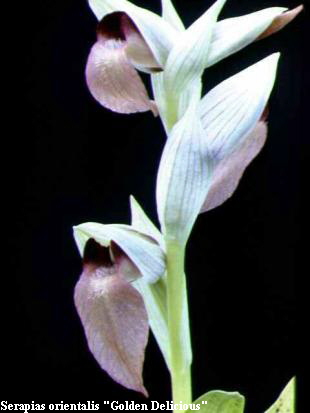
Serapias orientalis X Serapias neglecta. This cross has not yet flowered. The parents are very different and pleasantly scented. The plants grow very well..
Distribution:
Endemic around the mediterranean sea. Occuring mainly in coastal
regions with fewer populations further inland in Spain, France and
Italy.
Description:
The genus Serapias consists of more than 20 species. Many species
are only recently described and some are still undescribed. Leaves
are long and relatively narrow. The flowers of most species are
large. Sepals and Petals form a helmet (tubular galea), from which
a prominent lip (tongue) projects. Often, Serapias are assumed to
be pollinated by insects, searching for a shelter during the night
or in bad weather. Contrary to this assumption, many species are
scented during nice and warm weather, each species producing a very
different set of perfume.
Culture:
Serapias is easy in cultivation. All plants are summer dormant
and rest as tuberoids. Plants emerge in late summer and flower in
spring and early summer. Culture sunny or lightly shaded. Regular
watering during the growing period is essential. Fertilized on a
regular basis with 0.3g/l until flowering, once or twice a month.
Reduce watering with the onset of flowers and stop as the leaves
die back. Completely dry during dormancy in pot culture. Occasionally
a light spray of water for small plants and seedlings to prevent
dehydration. If grown inside, move plants temporary outside in late
summer as cool nights and some rain will stimulate plants into the
new growing season. Frost hardy up to -6°C.
Recommended potting mixes:
70% fine to medium grade perlite, pumice or fine expanded clay
give good results. 30% organic components. Favourable are
fermented or N-impregnated wood shavings or saw dust. (Toresa has
given good results.) 30% peatbased mixes as TKS1 have given even
good results. Spagnum moss is not suitable. Substrates have to be
well draining with a pH of about 6.
Further reading:
Orchids of Britain & Europe. Pierre Delforge, 1995.
Collins Photo Guide. ISBN 0 00 2200244.
Orchideen im Garten: Verwendung, Pflege und Vermehrung. Gerd
Kohls und Ulrich Kähler, 1993. Parey ISBN 3 489 63624 4.
Orchideen für den Garten: Europäische und tropische Erdorchideen.
Alfons Bürger, 1992. Ulmer ISBN 3 8001 6487 6.
Hardy orchids. Phillip Cribb and Christopher Bailes, 1989.
Timber Pr. ISBN 0 88192 147 5.